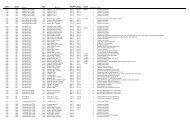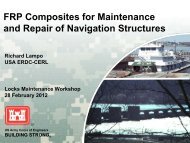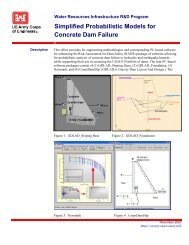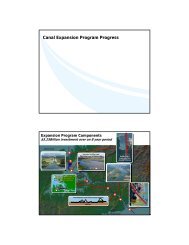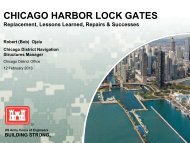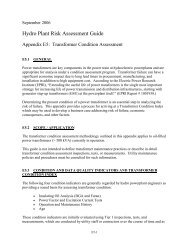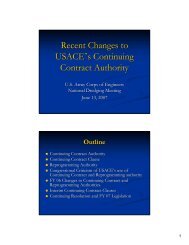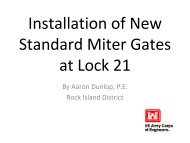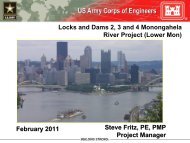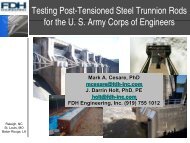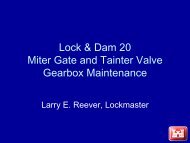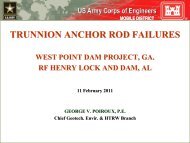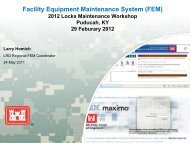Hydro Plant Risk Assessment Guide
Hydro Plant Risk Assessment Guide
Hydro Plant Risk Assessment Guide
You also want an ePaper? Increase the reach of your titles
YUMPU automatically turns print PDFs into web optimized ePapers that Google loves.
Test T2.2: Valves<br />
Valves – Structural Integrity<br />
The physical deterioration of emergency closure valves is likely to be from one or more of the<br />
following factors:<br />
1) Corrosion<br />
2) Yielding, Fracture, Fatigue and Fabrication Discontinuities<br />
3) Field Repair and Modification<br />
4) Miscellaneous Damage and Conditions<br />
Test T2.2.1: Valves – Corrosion<br />
Some major contributing factors to corrosion are: the pH and ion concentration of the river,<br />
relative humidity of 40% or more, ineffective protective coatings (due to age, improper<br />
formulation, or improper application), cavitation, and malfunctioning or improperly maintained<br />
cathodic protection systems. Also, dissimilar metals in contact can cause a dielectric reaction<br />
and cause one of the metals (usually carbon steel) to corrode at an accelerated pace. For valves,<br />
cavitation is typically more significant than oxidation.<br />
Table 17 – Corrosion<br />
Results<br />
Good – Corrosion has not caused significant loss of cross-sectional<br />
area for structural elements, localized corrosion has not reduced<br />
weld area significantly, protective coating in good condition, little<br />
or no cavitation.<br />
Moderate – Small amounts cross-sectional area has been lost in<br />
some elements, there is isolated plate separation from corrosion,<br />
some pitting, some weld area reduction in some welds, protective<br />
coating in fair condition, moderate cavitation.<br />
Severe – Significant cross-sectional area loss in critical members,<br />
significant weld size loss due to corrosion, significant pitting<br />
protective coating in poor condition, severe cavitation damage.<br />
Adjustment to<br />
Condition Index Score<br />
Add 1.0<br />
No Change<br />
Subtract 1.0<br />
T2.2.2: Valves – Yielding, Fracture, Fatigue, and Fabrication Discontinuities<br />
Yielding and fracture of structural members and weldments can compromise structural integrity<br />
and deserve special attention. They can occur from a variety of causes including, but not limited<br />
to: impact, fatigue loading, material defect, and design overload.<br />
Fractures usually occur where there are local stress raisers. This occurs where there is a local<br />
geometry change. Examples of this are bolt/rivet holes, sharp inside corners, corrosion pits, and<br />
weldments. Cracking of weldments or base metals is particularly problematic where thick<br />
members are welded together or there are dimensioning errors. Improper welding techniques<br />
E11-19



